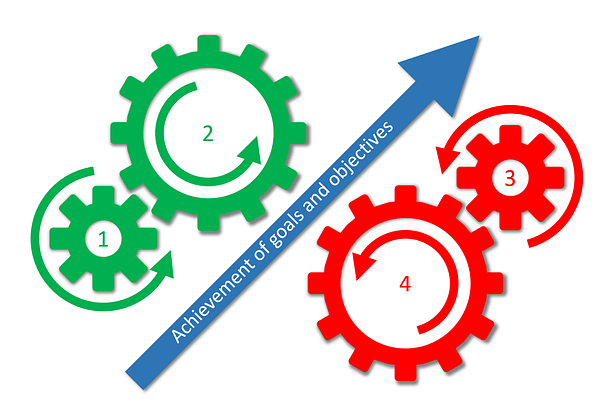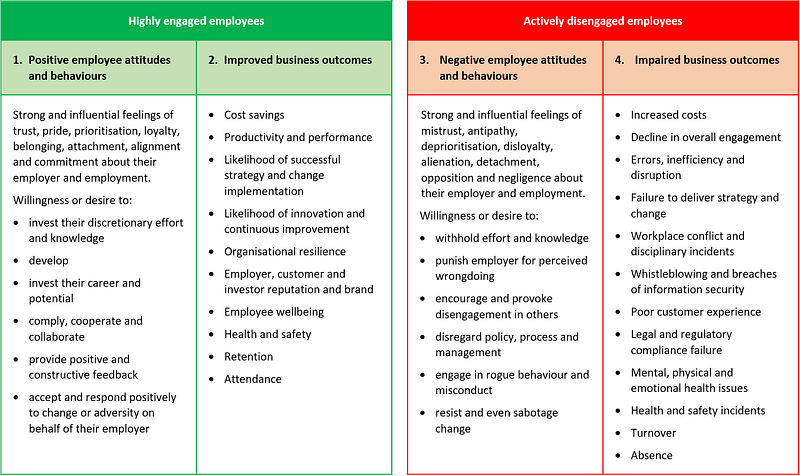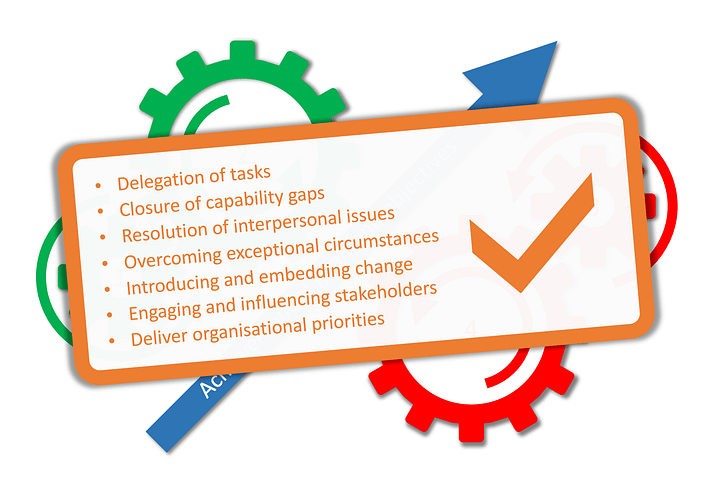
PART 1 - CONTEXT AND PURPOSE
Introduction: Employee engagement is highly relevant today
At the height of the recession, Engage for Success was commissioned by the UK Secretary of State for Business, Innovation and Skills to examine whether a more robust and proactive approach to employee engagement across UK industry could contribute meaningfully to national economic strength and resilience in the face of global crisis and competition.
We concluded, yes, employee engagement is a key with which we can unlock performance, productivity and profitability. Not only that – and not coincidentally – the right approach to employee engagement can have a transformational impact on employee wellbeing.
Ten years have passed. For the majority of employers and employees the sense of crisis has endured. In the face of profound political, economic, social, technological and environmental change, we all continue to feel the pressures of volatility, uncertainty, complexity and ambiguity.

Click to open report
To survive, stabilise and grow, organisations are pushing many boundaries. They have sought – and are seeking still – to become more innovative, more efficient and more resilient. In the midst of all this, employee engagement has gained recognition and validation at the heart of modern, enlightened business strategies.
The challenges remain; so do the opportunities; and we all have important roles to fulfil – responsible for our own engagement as well as those around us.
The broader context: people management
Managers inhabit a complex and dynamic world of people, process and technology – bridging the gap between strategy and operations. They are integral to how organisations function and grow.
Unless you’re an individual contributor, you probably don’t operate in isolation. First and foremost, your role is defined by leadership of a team or department. Your team is responsible for delivering your objectives while you are responsible for managing the team and its performance.
This occurs at two levels:
- Team level. You are responsible for ensuring the effectiveness and efficiency of your team as an organisation in its own right.
2. Employee level. You are responsible for ensuring the effectiveness and efficiency of each individual member of the team.
The ‘people management’ aspects of team management and administration are often defined as a framework of processes covering team resourcing (e.g. recruitment, selection and onboarding), team development (e.g. training, talent management and succession planning), team performance management (e.g. objective setting, performance review and absence management), team reward management (e.g. payroll and pay review) and leaver management.
In other words, you are responsible for optimising team and individual performance and contribution, which you fulfil by facilitating these processes and managing the employer-employee relationship.
What employers want from their people and people managers
Increasingly, employers recognise that success depends on employees at all levels. The appetite for ‘talent’ – for ‘assets’ rather than ‘resources’ – has been building. It is no longer enough that employees develop core capabilities and follow orders; all the value in every individual must be unlocked and channelled to good effect.
Employees are expected to thrive – not simply survive – in a climate of increasing complexity, challenge and change.
Optimisation of the workforce has introduced improved provision for human needs and tighter mitigation of human inefficiencies. The emphasis is on employee behaviour, wellbeing, resilience and self-sufficiency.
It is anticipated that the workforce of tomorrow will need to be more driven, more capable, more adaptable and more resilient – aligned to strategic priorities, streamlined and appropriately enabled by technology, process, communication and culture.
Increasingly, therefore, employers require people managers to operate more as leaders and coaches and less as managers in the traditional sense. They are expected to enhance team delivery whilst helping to identify and develop organisational talent. They are expected to deliver competitive advantage from employees whilst enabling real, meaningful and sustainable change. There is increasing emphasis on their strategic role and creating a responsible working environment that is conducive to diversity, innovation and transformation.
Employee engagement: what it is and why it matters
Specific definitions of employee engagement vary. They are often based on what it looks like rather than what it is – identifying key causes, symptoms and consequences. As a result, engagement is often defined as a set of contributing factors, a psychological state or a set of behavioural outcomes.
The various contemporary definitions of employee engagement are more complementary than contradictory. It is consistently agreed that employee engagement is a good thing for employers and employees alike.
We choose to define employee engagement as follows:
Employee engagement is a workplace approach resulting in the right conditions for all members of an organisation to give of their best each day, committed to their organisation’s goals and values, motivated to contribute to organisational success, with an enhanced sense of their own wellbeing.
In other words, employee engagement is about creating the conditions in which employees contribute more and better, and placing this at the heart of business strategy. To do so sustainably we have to accept that levels of engagement are fluid and constant, not static and existing only when measured.
Care should also be taken to understand, identify and mitigate the risks of disengagement.
“What is disengagement? Fundamentally, it is a state of distance from one’s work. A disengaged employee puts in time but little else, and his apathy affects not only his own productivity but that of his colleagues…And disengagement is costly.” Christina Bielaszka-DuVernay, Harvard Business Review, ‘Micromanage at Your Peril’
As can be seen from the table below, however, apathy may be disengagement at its best. Disengagement should not be mistaken for merely the absence of engagement. It may be better understood as the opposite end of the engagement spectrum.
Levels of engagement among employees can have a positive, self-reinforcing presence in the workplace, and an increasingly beneficial impact as those levels rise. Employees may become increasingly invested in organisational success.
Disengagement, on the other hand, has a negative presence, and as levels of disengagement rise, the impact can become profoundly detrimental. Employees may drift from the apathetic into the antagonistic. Even highly engaged employees can become actively disengaged if driven to it by the right – or rather wrong – turn of events or organisational and managerial behaviours.
The specific benefits of highly engaged employees and risks of actively disengaged employees can vary by context, but the majority of academics, practitioners and other commentators all tend to agree on the following:


Click image to enlarge
The benefits of employee engagement for you, the manager
The benefits of engaged employees do not manifest from the top down. Their immediate impact is at source (i.e. engaged individuals) and accumulates upwards through the organisation, driving increased scales of benefit.
For you, therefore, there is tremendous opportunity to enjoy the benefits of a highly engaged team ahead of the rest of the organisation. By stimulating and cultivating the right attitudes and behaviours you can enhance team efficiency, productivity and performance dramatically.
For example:

Meanwhile, employee demand for your intervention is reduced, freeing you up to become more engaged with the more strategic aspects of your role as well as your own professional development.
All in all, the engaging manager has the opportunity to improve their own employment experience whilst generating a distinct reputation and career advantage.
The Engaging Managers' Zone: why, who, and what
The Zone is intended to encourage and enable ‘engaging managers’ by providing impartial information and guidance as well as opening access to applicable knowledge and best practice. At the same time, we want to promote the strategic and operational value of engaging managers, whilst helping to strengthen the national practitioner community.
The Zone is for you. It belongs to everyone for whom success depends on being able to engage people effectively. We’ll look at employee engagement in the day-to-day reality of contemporary people management, with emphasis on the outcomes you’re responsible for.
There’s a lot of confusing ‘noise’ out there about managers and employee engagement. There is information of value, but it takes time and knowledge to find and validate it.
The Zone is a supportive starting point. Here you can baseline and enrich your understanding and thinking. We’ll filter and make sense of the noise for you, synthesising everything of value to make it easier to navigate, digest and apply.
Beyond this we offer breathing space and an opportunity to ‘take a step back’. We aim to provide clarity, friendly challenge and reassurance with a sense of practical direction, momentum and do-ability.
In the Engaging Managers’ Zone you will find:
- ‘Employee engagement’ and ‘engaging managers’ explained in the broader context of contemporary management roles, including the benefits of employee engagement specific to people management and people managers, and the specific responsibilities that must be fulfilled in order to realise those benefits.
- How to take ownership of employee engagement by clarifying your objectives, building an appropriate strategy, identifying potential constraints, barriers and enablers, and – perhaps most important of all – by taking ownership of your own engagement.
- A guide to your employee engagement landscape and the drivers of engagement and disengagement, including a review of how you can maximise the benefits and mitigate the risks.
- How to enhance your approach and become an exceptionally engaging manager by monitoring employee engagement and encouraging your team to manage their own engagement.
- A guide to taking action and making change happen.
How to get the most out of the Engaging Managers' Zone
We believe you’ll find everything in the Zone to be of value, but we don’t expect you to read it from ‘cover to cover’. Instead, we invite you to browse and explore, follow your interests and let your priorities determine where and how you drill into the detail.
We hope you find the content encouraging and thought-provoking. The Zone is a source of ideas, options and things to think about. It is not our intention to prescribe ‘the answer’ or any ‘quick fixes’. We’ll encourage you to ask your own questions and reflect on what your answers might be.
It may be that you’re already taking appropriate action. We hope we can help you to validate your existing plans and build on those foundations.
On the other hand, change may be required. Don’t be shy about challenging yourself, but resist the urge to be overly self-critical. Look to the future, not the past. Focus on things getting better.
Think carefully, but remember: there is no ‘right’ or ‘wrong’ approach. Follow what feels right and accept that we learn and improve through trial, error and experience. Change is challenging. It can take time to see results. At the same time: meaningful change is not necessarily radical change.
Employee engagement is not a switch you can flick from ‘off’ to ‘on’, or ‘low’ to ‘high’. It is not a recent discovery; not a fad; not an initiative. It runs much, much deeper. It is – and has always been – a natural, inherent and vital element in any field of employment.
It cannot be controlled, but it can be channelled and influenced. It is a tremendous and worthwhile opportunity, not a puzzle to solve overnight.
We believe that every manager should aspire and strive to be an engaging manager. But, to borrow from a popular quote about engagement, “…you have to want to be. There has to be deep-seated desire in your heart and mind to participate, to be involved, and to make a difference. If the desire isn’t there, no person or book can plant it within you.”

